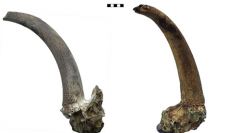

 Comptes Rendus Palevol
11 (4) - Pages 241-249
Comptes Rendus Palevol
11 (4) - Pages 241-249Three Capra pyrenaica pyrenaica skulls from the Holocene found in different karstic sinkholes in the mid-western Pyrénées are described. Two of the locations were at the highest elevations known for Capra fossils in the Pyrénées, which provides insights into the timing of the Holocene deglaciation. The skulls of the males were particularly large relative to those of other Capra from the Upper Pleistocene found in southwestern Europe. An increase in the availability of food, rather than a direct influence of global warming, during the Holocene (Bergmann's Rule) was likely responsible for the large size of the skulls. Comparisons between the horn sections of the Pyrenean skulls and those of neighbouring taxa show a morphological similarity between the former and C. i. ibex .
Pyrenean wild goat, Capra evolution, Southwestern Europe, Caprinae, Sexual dimorphism